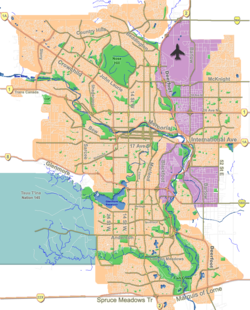
This is a list of neighbourhoods in Calgary, Alberta.
Contents
- Centre City
- Downtown
- Other
- Inner city
- Quadrants
- List
- Notable Sub-Communities
- Former Communities
- Business Improvement Areas
- Planning Areas
- Known Planning Areas
- Industrial areas
- Gallery
- See also
- References
- External links
As of 2016, Calgary has 197 neighbourhoods, which are referred to as "communities" by the municipal government, [1] and 42 industrial areas. [2] A further 15 communities were included in the civic censuses from 2015 to 2019, [3] bringing the total to 212. Calgary Open Data also confirms six more communities yet to be developed (Alpine Park, Ambleton, Glacier Ridge, Lewisburg, TwinHills, and Symons Valley Ranch). [2]





























